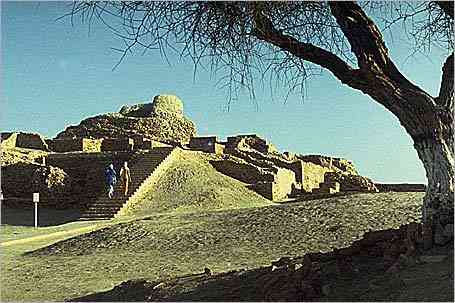|
The Ancient Civilization
"Moen Jo Daro" Larkana
| |

Mohenjo-daro (Urdu:
موئن جودڑو, Sindhi: موئن جو دڙو, English: Mound of
the dead) was a city of the Indus Valley Civilization built around 2600
BC and is located in the Sindh Province of Pakistan. This ancient five
thousand year old city is the largest of Indus Valley and is widely
recognized as one of the most important early cities of South Asia and
the Indus Valley Civilization. Mohenjo Daro was one of the world’s first
cities and contemporaneous with ancient Egyptian and Mesopotamian
civilizations. It is sometimes referred to as "An Ancient Indus Valley
Metropolis".
|
|
| |

Stupa |
The Indus Valley civilization
flourished around 2,500 B.C. in the western part of South Asia,
in what today is Pakistan and western India. It is often
referred to as Harappan Civilization after its first discovered
city, Harappa. |
| The Indus Valley was home to the
largest of the four ancient urban civilizations of Egypt,
Mesopotamia, India and China. It was not discovered until the
1920's. Most of its ruins, including major cities, remain to be
excavated. Its script has not been deciphered. Basic questions
about the people who created this highly complex culture are
unanswered. |

Enterence |

Findings from ruins of moen jo daro |

Dancing Girl |
The Harappans used the same size
bricks and standard weights for a thousand miles. There were
other highly developed cultures in the area. Some are thousands
of years older. Harappa was settled before the Harappans of the
Indus Valley, and they were replaced by other still anonymous
peoples. |
| In fact, there seems to have been
another large river which parallel and west of the Indus in the
third and fourth millenium B.C. This was the ancient
Ghaggra-Hakra River or Sarasvati of the Rig Veda. Its lost banks
are slowly being laid out by researchers. Along its bed, a whole
new set of ancient towns and cities have been discovered.
|

Priest |
|
 
Findings from ruins of moen jo daro |

Street |
Ancient Mesopotamian texts speak
of trading with at least two seafaring civilizations - Makkan
and Meluha - in the neighborhood of India in the third
millennium B.C. This trade was conducted with real financial
sophistication in amounts that could involve tons of copper. The
Mesopotamians speak of Meluha as an aquatic culture, where water
and bathing played a central role. A number of Indus Valley
objects have been found buried with Mesopotamians. |
| This doorway starts telling the
story of the Indus Valley as a series of chapters. It follows
the re-discovery of Harappa in the early 19th century by the
explorers Charles Masson and Alexander Burnes, and the
archaeologist Sir Alexander Cunningham in the 1870's. This work
led to the the first excavations in the early 20th century at
Harappa by Rai Bahadur Daya Ram Sahni, and by R.D. Banerji at
another Indus Valley city, Mohenjo-daro. |

Well |

Bath |
Since 1986, the joint Pakistani
American Harappa Archaeological Research Project (HARP) has been
carrying out the first major excavations at the site in forty
years. These excavations have the shown Harappa to have been far
larger than once thought, perhaps supporting a population of
50,000 at certain periods. These excavations, which continue in
1998, are rewriting assumptions about the Indus Valley. New
facts, objects and examples of writing are being discovered each
season. |
Location of Moenjo Daro
Moen-Jo- Daro is located in District Larkana at a
distance of about 27 km from Larakana and 107 km from Sukkur. It
lies on 27o 19' 30.36" North
latitude and 68o 08' 08.77" East
longitutide at an elevation of about 164 ft from sea level.
|
|
|
For visiting moen jo
daro in Larkana, Sindh, Pakistan, ApnaLarkana.com team can plan a
trip, reserve hotel and arrange a guide for you with safety and security,
contact us for more details.
|







